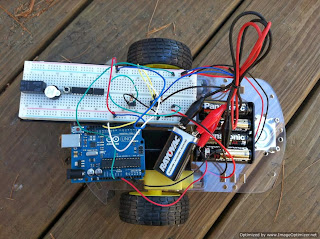My Experiments with the PICAXE 08M2+

PICAXE 08M2+ I generally prefer to do things the hard way. For example, you can either microwave a frozen dinner or cook from scratch. The microwave option is a good backup plan, but cooking from scratch has far too many advantages, as I outlined in a recent blog post on the do-it-yourself way of life. In the electronics and robotics world, the analogy of cooking from scratch is to build circuits using a bare bones micro-controller chip (e.g. the PICAXE ) rather than a fancy board (e.g. the Arduino ). Therefore, once I get a circuit working with the packaged Arduino approach (e.g. this robot I built recently), I usually try to replicate the circuit using more basic components like the PICAXE. My decision to consider the PICAXE was influenced by Charles Platt's coverage of it in his awesome book Make: Electronics . But essentially, I am a minimalist and I want to see how much I can get done with a bare bones chip rather than a bulky board-based micro-controller like the Ar...






